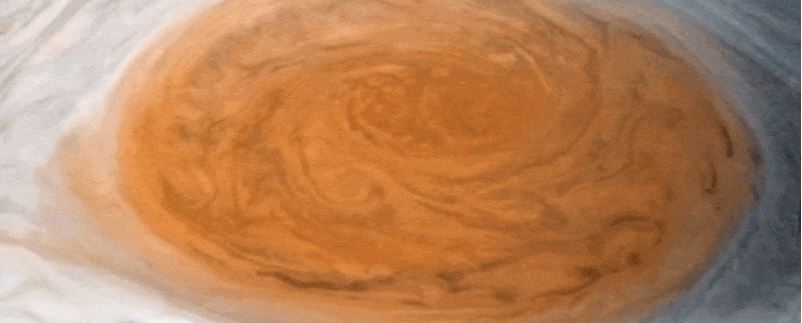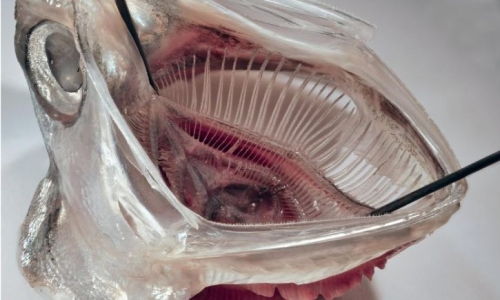


 3:2:35
3:2:35  2024-07-31
2024-07-31  1145
1145

It's the iris in the great eyeball of Jupiter, revolving to gaze balefully out upon the cosmos: the Great Red Spot, the single largest, longest-lived storm in the entire Solar System.
Humanity has been observing it for centuries, a colossal anticyclone currently a little bit larger than Earth, with winds that howl around in an anticlockwise direction at up to 680 kilometers (425 miles) per hour.
As mighty as it rages, however, the Great Red Spot has significantly diminished since the first definite records of its existence in 1831. The storm was once much larger; over time, it has dwindled, and it dwindles still.
Scientists now think they understand why: The Great Red Spot feeds off of other, smaller storms merging into it. If there aren't those smaller storms for the Great Red Spot to devour and subsume, it will be unable to maintain its prodigious dimensions.
"Many people have looked at the Great Red Spot over the last 200 years and were as fascinated by it as I am," says astronomy PHD Caleb Keaveney of Yale University.
"We found through numerical simulations that by feeding the Great Red Spot a diet of smaller storms, as has been known to occur on Jupiter, we could modulate its size."
Once, back in the late 19th century, the Great Red Spot spanned a whopping 39,000 kilometers across. Now, it's just over a third of that width at 14,000 kilometers. Earth's 12,742-kilometers diameter could still fit inside – but it's getting to be a tighter squeeze. We've never seen the Spot so (relatively) small.
Scientists have been investigating this strange phenomenon, but it's a puzzler. Jupiter is very different from Earth, and its weather much wilder. In spite of these differences, though, fluids – such as atmospheric gasses – behave in certain ways that can be explored using the mathematics of fluid dynamics.
And, while we can't extrapolate 1:1 the behavior of Earth's weather onto Jupiter, we can use our understanding of Earth's atmospheric processes to try to figure out what is happening on Jupiter. This is what Keaveney and his colleagues have done.
We know, from research published in 2021, that Jupiter's Great Red Spot effectively 'eats' smaller storms it encounters, growing larger in the process. So, the researchers used a similar phenomenon observed here on Earth to inform their models of Jupiter's atmosphere.
In the jet streams that circulate through Earth's atmosphere, long-lived, high-pressure systems called heat domes, or blocks, can form, where the jet stream slows to a halt. These blocks can play a significant role in heat waves and droughts as they trap warm temperatures below them for long periods.
The longevity of these blocks has been linked to anticyclones and other smaller weather phenomena. Equipped with this information, the researchers created a model for Jupiter's atmosphere and the Great Red Spot, simulating interactions between the storms.
They found that, when a smaller storm encountered the Great Red Spot, the former storm would maintain its size, or grow, compared to simulations without these interactions. And the degree to which the Spot was sustained was stronger if there were more interactions. Finally, the strength of the smaller storm played a role, too. A stronger storm gave the Great Red Spot a bigger boost.
There's nothing we can really do about the Great Red Spot. Jupiter is going to Jupe, we're just here to enjoy the show. But learning about its amazing atmosphere can help us better understand the way weather works on our own planet, which is pretty neat.
"Our study has compelling implications for weather events on Earth," Keaveney says.
"Interactions with nearby weather systems have been shown to sustain and amplify heat domes, which motivated our hypothesis that similar interactions on Jupiter could sustain the Great Red Spot. In validating that hypothesis, we provide additional support to this understanding of heat domes on Earth."
Reality Of Islam |
|

A new study

Researchers

A new chip-

A large inf
 9:3:43
9:3:43
 2018-11-05
2018-11-05
10 benefits of Marriage in Islam
 7:5:22
7:5:22
 2019-04-08
2019-04-08
benefits of reciting surat yunus, hud &
 9:45:7
9:45:7
 2018-12-24
2018-12-24
advantages & disadvantages of divorce
 11:35:12
11:35:12
 2018-06-10
2018-06-10
 6:0:51
6:0:51
 2018-10-16
2018-10-16
 5:57:34
5:57:34
 2023-03-18
2023-03-18
 8:25:12
8:25:12
 2022-03-09
2022-03-09
 11:2:27
11:2:27
 2022-10-06
2022-10-06
 7:6:7
7:6:7
 2022-03-21
2022-03-21
 7:34:7
7:34:7
 2023-02-28
2023-02-28
allah will not answer all your prayers
 6:56:28
6:56:28
 2022-01-01
2022-01-01
 2:33:4
2:33:4
 2023-02-15
2023-02-15
 5:41:46
5:41:46
 2023-03-18
2023-03-18
| LATEST |